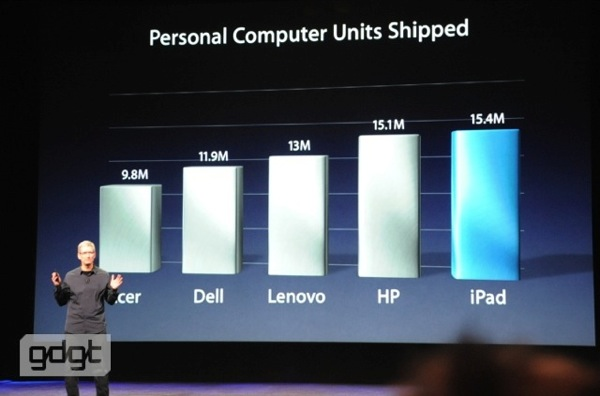It’s not all rosy in Apple’s Walled Garden.
Take the curvature of the back panel in tandem with the thinner profile. This actually makes the new iPad less comfortable to hold than the iPad 1. It digs into the palms at the corners and over a short period of time quickly becomes tiresome.
Then there is the interface between the touch-screen glass and the metal back, which curves to meet the glass. It’s inconsistent. There are no issues with this interface on the iPad 1st generation, but on the new iPad, there is some roughness. This roughness alone makes the interface between hands and device especially uncomfortable. It lacks the quality I’ve come to expect from Apple. I can’t believe the likes of John Gruber have missed this, unless I’ve got a dud.
The curvature of the back panel is deliberate of course, it gives the appearance of thinness without requiring it. Apple has realised since the rev A MacBook Air (yes, I have one of those too) that a side-on shot of a device with taper gives the illusion of the object floating in space and thinner than if the height was determinable by a single, two dimensional plane. It’s just design. And it works, even when you know the truth.
What doesn’t work is the configuration of interfaces along the edges. There is no way around this for Apple until they get the device _really_ thin, at which point they can take the iPhone 4 route and go back to the metal band design language. It’s really difficult to insert the dock connector without seeing the port. It takes longer to find the lock button. I fumble around for the volume rocker switch and I’m never really sure if I’ve hit the right bit until I see which way the volume is going. I have to visually find the on/off switch. This is ergonomics 101. It was spot-on with the first gen iPad and it’s just broken since second gen.
From time to time I like to experiment with Xcode, openFrameworks and targeting the iPad with toys. It’s how I wind down from time to time. The new iPad suffers here too as far too often, debug processes are left hanging on this device, necessitating a full power cycle. This means I’m no longer interested in experimenting and will stick to the Mac. Life’s too short to file RDAR requests that will never get answered. Life’s too short to file RDAR requests full stop.
The battery life is definitely shorter. The first gen iPad lasted forever. The new one is still mightily impressive, knocking every laptop under the sun into a cocked hat, but you have to think about whether it will last two reasonably busy days. First gen did two days without breaking a sweat.
It does get warm. Certainly not blisteringly hot the way my MacBook Air rev A used to get, but pretty warm when you’ve been gaming for ahem, a few, ahem (60) minutes with the brightness turned up to maximum. Taking the brightness down a few notches helps a lot I’ve found. It’s definitely hotter at the bottom left on the back panel.
This might sound lame, but I often mistake the camera at the top for the front panel button. It’s because I was used to just a single visible circle on the first gen iPad and so mistake the camera for that circle. I would be surprised if I was the only one who made this mistake.
It’s definitely lighter, but it’s no Kindle. That means it’s still not comfortable to hold in a single hand, but then I expect it never will be.
The Smart Cover, which I eventually caved in and bought is not so smart. I hear the cover switch being triggered in my bag as the covered device moves around; I often trigger the cover switch even when I’m just carrying it in my hand. It’s hopeless folding it over the back for reading, so I just take it off, which is a shame, because that’s the only time it does cover the back and if Apple think their fans don’t care about the backs of their devices, they’re wrong. I use a cut-to-size polythene sleeve. It’s paper thin and it protects both sides.
The Smart Cover does works well in its two stand orientations Though and while we’re closing on a positive note, the Retina Display, the raison d’être of the device is a thing of wondrous beauty. I knew it was coming as soon as the iPhone 4 came out and I knew I’d buy it when it came. It did and I did. The power of the thing is also impressive, taking everything in its stride and restoring the tarnished “magical” label.
Despite the flaws, the new iPad is still the one device I would not do without. This article was written on it, on a 98 bus, without the Smart Cover, at less than full brightness.
